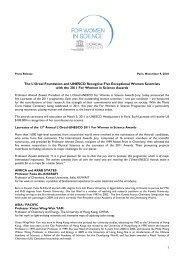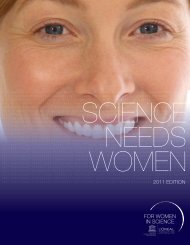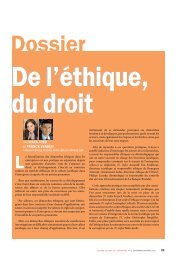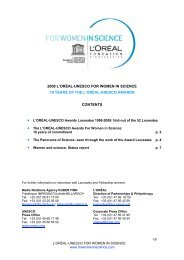CONTENTS - L'Oréal
CONTENTS - L'Oréal
CONTENTS - L'Oréal
You also want an ePaper? Increase the reach of your titles
YUMPU automatically turns print PDFs into web optimized ePapers that Google loves.
Society. Because there are no astronomical<br />
observatories in Tunisia, theoretical scientific research is<br />
conducted on interstellar molecules and stellar plasmas.<br />
In 1994 Professor Ben Lakhdar was elected to the Islamic<br />
Academy of Sciences. Since 2001, she has been a senior<br />
associate member at the Abdus Salam International<br />
Centre for Theoretical Physics-ICTP. She has chaired<br />
international conferences in her field of specialization,<br />
atomic spectroscopy, and has organized many<br />
cooperation programs with European laboratories. Most<br />
recently she chaired the Sixth International Workshop on<br />
Laser Physics and its Applications, held in Tunis.<br />
Context of the Laureate’s research<br />
A luminous physics<br />
L’ORÉAL-UNESCO FOR WOMEN IN SCIENCE 2005<br />
L’ORÉAL-UNESCO AWARDS 2005: The Laureates<br />
“Light is the messenger of the Universe.” This was the<br />
title of a lecture given by Professor Ben Lakhdar, and it is<br />
a very vivid illustration of a miracle of physics which is<br />
continually renewing itself: light informs us about the<br />
state of matter throughout the universe and even about<br />
the universe’s past. Zohra Ben Lakhdar’s work falls<br />
completely within the ambit of analyzing bodies<br />
according to the spectrum of light they emit or absorb.<br />
We use light to detect the existence of atoms and the way<br />
they combine to form molecules, as well as their speed,<br />
temperature, energy state, and the way they associate<br />
with surrounding molecules.<br />
Light informs knowledge<br />
What a distance we have traveled! The philosopher<br />
Auguste Comte denied the possibility that we would ever<br />
come to know the composition of the Sun, the stars and<br />
the planets. It is a harsh lesson: you should not always<br />
believe the defeatist utterances of philosophers, because<br />
just a few years after Comte’s statement the German<br />
physicist Joseph von Fraunhofer showed that a body’s<br />
light emission was characteristic of the nature of the<br />
emitting element, and that one could therefore find out<br />
the composition of the stars.<br />
When she was a student in Paris, Zohra Ben Lakhdar was<br />
familiar with the prestigious Kastler-Brossel Laboratory<br />
where Alfred Kastler demonstrated for the first time the<br />
phenomenon of stimulated emission Einstein had<br />
predicted. Light falling on an atom in a particular state<br />
could be amplified by that atom through a chain reaction.<br />
This has given us the laser, which is now used<br />
everywhere: there are fewer and fewer homes in the<br />
developed and developing world that do not contain at<br />
least one laser, whether it is in a CD or DVD player, in a<br />
printer or in a diode. Then, after they had been produced<br />
in the laboratory, the phenomena of laser-type light<br />
amplification were observed in nature, in interstellar<br />
space. One of Zohra Ben Lakhdar’s most important<br />
pieces of research is the calculation of the conditions<br />
under which this laser effect could manifest itself in<br />
space matter.

















